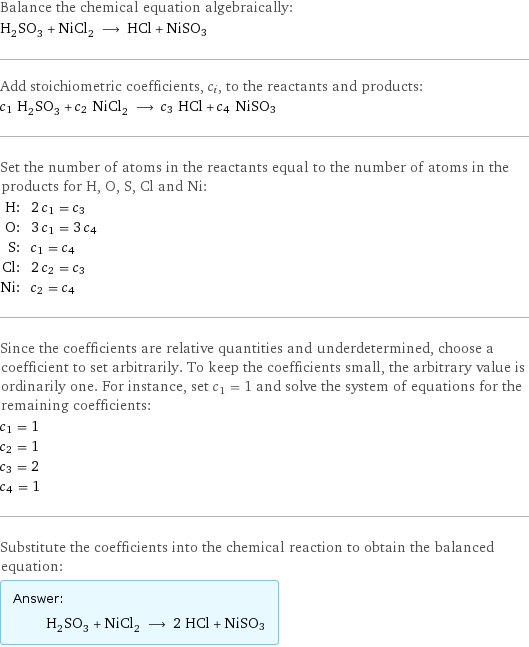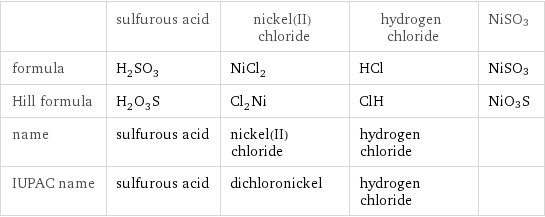Input interpretation

H_2SO_3 sulfurous acid + NiCl_2 nickel(II) chloride ⟶ HCl hydrogen chloride + NiSO3
Balanced equation

Balance the chemical equation algebraically: H_2SO_3 + NiCl_2 ⟶ HCl + NiSO3 Add stoichiometric coefficients, c_i, to the reactants and products: c_1 H_2SO_3 + c_2 NiCl_2 ⟶ c_3 HCl + c_4 NiSO3 Set the number of atoms in the reactants equal to the number of atoms in the products for H, O, S, Cl and Ni: H: | 2 c_1 = c_3 O: | 3 c_1 = 3 c_4 S: | c_1 = c_4 Cl: | 2 c_2 = c_3 Ni: | c_2 = c_4 Since the coefficients are relative quantities and underdetermined, choose a coefficient to set arbitrarily. To keep the coefficients small, the arbitrary value is ordinarily one. For instance, set c_1 = 1 and solve the system of equations for the remaining coefficients: c_1 = 1 c_2 = 1 c_3 = 2 c_4 = 1 Substitute the coefficients into the chemical reaction to obtain the balanced equation: Answer: | | H_2SO_3 + NiCl_2 ⟶ 2 HCl + NiSO3
Structures

+ ⟶ + NiSO3
Names

sulfurous acid + nickel(II) chloride ⟶ hydrogen chloride + NiSO3
Equilibrium constant
![Construct the equilibrium constant, K, expression for: H_2SO_3 + NiCl_2 ⟶ HCl + NiSO3 Plan: • Balance the chemical equation. • Determine the stoichiometric numbers. • Assemble the activity expression for each chemical species. • Use the activity expressions to build the equilibrium constant expression. Write the balanced chemical equation: H_2SO_3 + NiCl_2 ⟶ 2 HCl + NiSO3 Assign stoichiometric numbers, ν_i, using the stoichiometric coefficients, c_i, from the balanced chemical equation in the following manner: ν_i = -c_i for reactants and ν_i = c_i for products: chemical species | c_i | ν_i H_2SO_3 | 1 | -1 NiCl_2 | 1 | -1 HCl | 2 | 2 NiSO3 | 1 | 1 Assemble the activity expressions accounting for the state of matter and ν_i: chemical species | c_i | ν_i | activity expression H_2SO_3 | 1 | -1 | ([H2SO3])^(-1) NiCl_2 | 1 | -1 | ([NiCl2])^(-1) HCl | 2 | 2 | ([HCl])^2 NiSO3 | 1 | 1 | [NiSO3] The equilibrium constant symbol in the concentration basis is: K_c Mulitply the activity expressions to arrive at the K_c expression: Answer: | | K_c = ([H2SO3])^(-1) ([NiCl2])^(-1) ([HCl])^2 [NiSO3] = (([HCl])^2 [NiSO3])/([H2SO3] [NiCl2])](../image_source/f89b84f26765b51bdc95715f915826a8.png)
Construct the equilibrium constant, K, expression for: H_2SO_3 + NiCl_2 ⟶ HCl + NiSO3 Plan: • Balance the chemical equation. • Determine the stoichiometric numbers. • Assemble the activity expression for each chemical species. • Use the activity expressions to build the equilibrium constant expression. Write the balanced chemical equation: H_2SO_3 + NiCl_2 ⟶ 2 HCl + NiSO3 Assign stoichiometric numbers, ν_i, using the stoichiometric coefficients, c_i, from the balanced chemical equation in the following manner: ν_i = -c_i for reactants and ν_i = c_i for products: chemical species | c_i | ν_i H_2SO_3 | 1 | -1 NiCl_2 | 1 | -1 HCl | 2 | 2 NiSO3 | 1 | 1 Assemble the activity expressions accounting for the state of matter and ν_i: chemical species | c_i | ν_i | activity expression H_2SO_3 | 1 | -1 | ([H2SO3])^(-1) NiCl_2 | 1 | -1 | ([NiCl2])^(-1) HCl | 2 | 2 | ([HCl])^2 NiSO3 | 1 | 1 | [NiSO3] The equilibrium constant symbol in the concentration basis is: K_c Mulitply the activity expressions to arrive at the K_c expression: Answer: | | K_c = ([H2SO3])^(-1) ([NiCl2])^(-1) ([HCl])^2 [NiSO3] = (([HCl])^2 [NiSO3])/([H2SO3] [NiCl2])
Rate of reaction
![Construct the rate of reaction expression for: H_2SO_3 + NiCl_2 ⟶ HCl + NiSO3 Plan: • Balance the chemical equation. • Determine the stoichiometric numbers. • Assemble the rate term for each chemical species. • Write the rate of reaction expression. Write the balanced chemical equation: H_2SO_3 + NiCl_2 ⟶ 2 HCl + NiSO3 Assign stoichiometric numbers, ν_i, using the stoichiometric coefficients, c_i, from the balanced chemical equation in the following manner: ν_i = -c_i for reactants and ν_i = c_i for products: chemical species | c_i | ν_i H_2SO_3 | 1 | -1 NiCl_2 | 1 | -1 HCl | 2 | 2 NiSO3 | 1 | 1 The rate term for each chemical species, B_i, is 1/ν_i(Δ[B_i])/(Δt) where [B_i] is the amount concentration and t is time: chemical species | c_i | ν_i | rate term H_2SO_3 | 1 | -1 | -(Δ[H2SO3])/(Δt) NiCl_2 | 1 | -1 | -(Δ[NiCl2])/(Δt) HCl | 2 | 2 | 1/2 (Δ[HCl])/(Δt) NiSO3 | 1 | 1 | (Δ[NiSO3])/(Δt) (for infinitesimal rate of change, replace Δ with d) Set the rate terms equal to each other to arrive at the rate expression: Answer: | | rate = -(Δ[H2SO3])/(Δt) = -(Δ[NiCl2])/(Δt) = 1/2 (Δ[HCl])/(Δt) = (Δ[NiSO3])/(Δt) (assuming constant volume and no accumulation of intermediates or side products)](../image_source/0be6ad4161e2fc9fc30ac8164033a5b2.png)
Construct the rate of reaction expression for: H_2SO_3 + NiCl_2 ⟶ HCl + NiSO3 Plan: • Balance the chemical equation. • Determine the stoichiometric numbers. • Assemble the rate term for each chemical species. • Write the rate of reaction expression. Write the balanced chemical equation: H_2SO_3 + NiCl_2 ⟶ 2 HCl + NiSO3 Assign stoichiometric numbers, ν_i, using the stoichiometric coefficients, c_i, from the balanced chemical equation in the following manner: ν_i = -c_i for reactants and ν_i = c_i for products: chemical species | c_i | ν_i H_2SO_3 | 1 | -1 NiCl_2 | 1 | -1 HCl | 2 | 2 NiSO3 | 1 | 1 The rate term for each chemical species, B_i, is 1/ν_i(Δ[B_i])/(Δt) where [B_i] is the amount concentration and t is time: chemical species | c_i | ν_i | rate term H_2SO_3 | 1 | -1 | -(Δ[H2SO3])/(Δt) NiCl_2 | 1 | -1 | -(Δ[NiCl2])/(Δt) HCl | 2 | 2 | 1/2 (Δ[HCl])/(Δt) NiSO3 | 1 | 1 | (Δ[NiSO3])/(Δt) (for infinitesimal rate of change, replace Δ with d) Set the rate terms equal to each other to arrive at the rate expression: Answer: | | rate = -(Δ[H2SO3])/(Δt) = -(Δ[NiCl2])/(Δt) = 1/2 (Δ[HCl])/(Δt) = (Δ[NiSO3])/(Δt) (assuming constant volume and no accumulation of intermediates or side products)
Chemical names and formulas

| sulfurous acid | nickel(II) chloride | hydrogen chloride | NiSO3 formula | H_2SO_3 | NiCl_2 | HCl | NiSO3 Hill formula | H_2O_3S | Cl_2Ni | ClH | NiO3S name | sulfurous acid | nickel(II) chloride | hydrogen chloride | IUPAC name | sulfurous acid | dichloronickel | hydrogen chloride |
Substance properties

| sulfurous acid | nickel(II) chloride | hydrogen chloride | NiSO3 molar mass | 82.07 g/mol | 129.6 g/mol | 36.46 g/mol | 138.75 g/mol phase | | | gas (at STP) | melting point | | | -114.17 °C | boiling point | | | -85 °C | density | 1.03 g/cm^3 | 3.55 g/cm^3 | 0.00149 g/cm^3 (at 25 °C) | solubility in water | very soluble | | miscible |
Units
